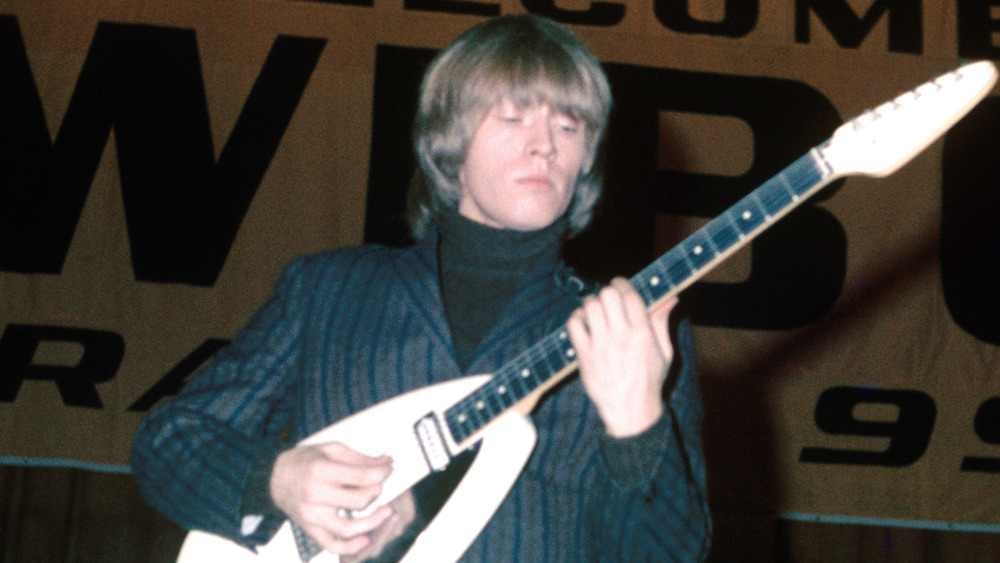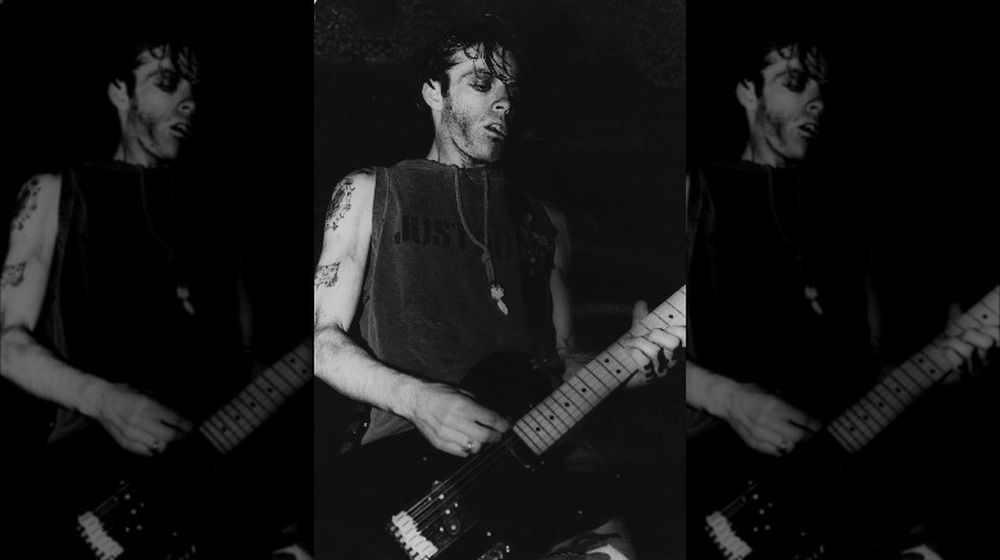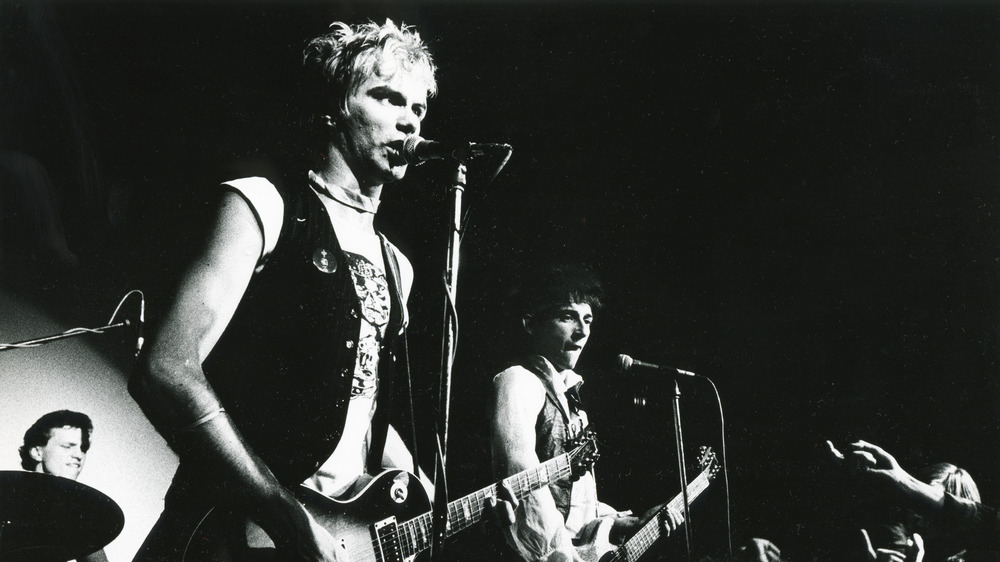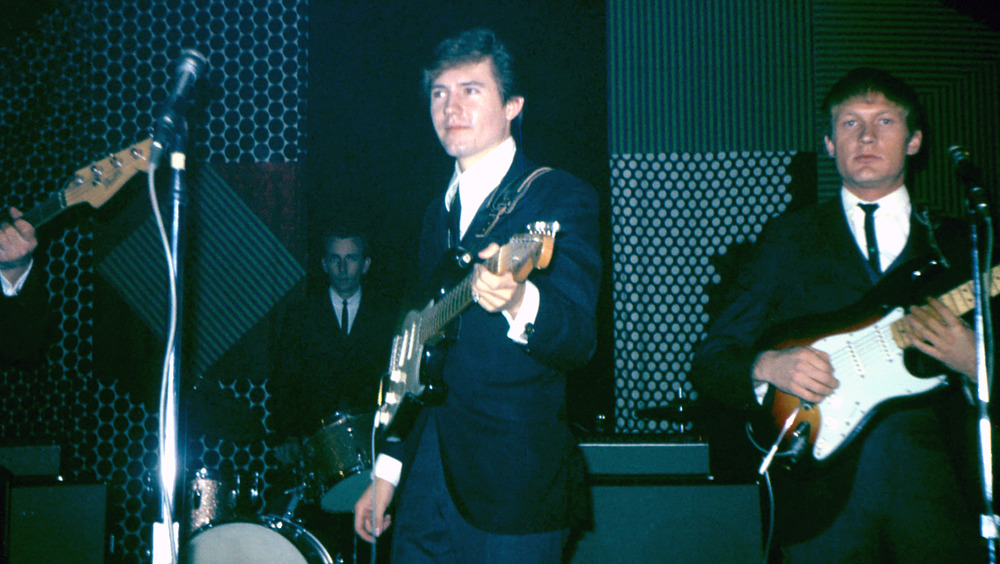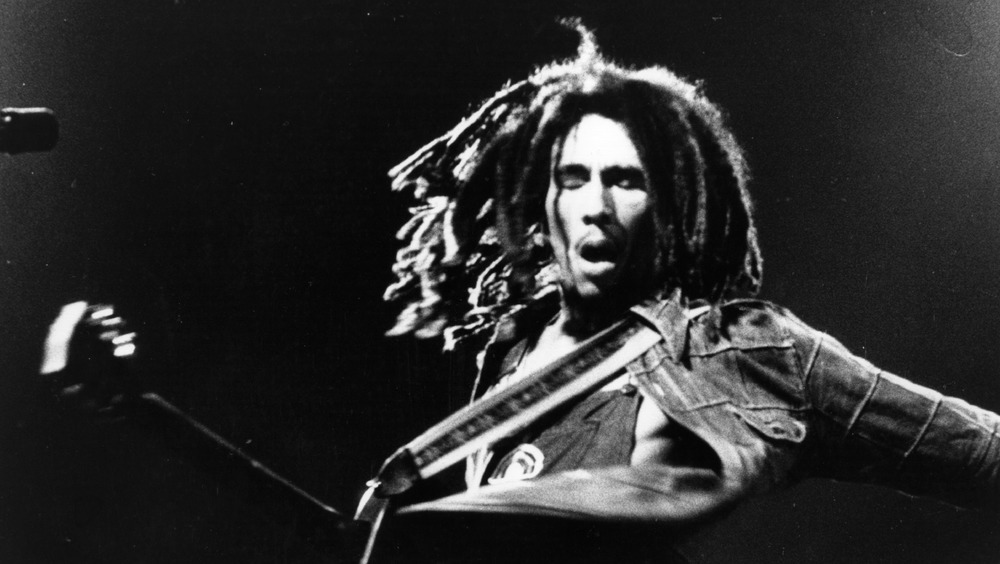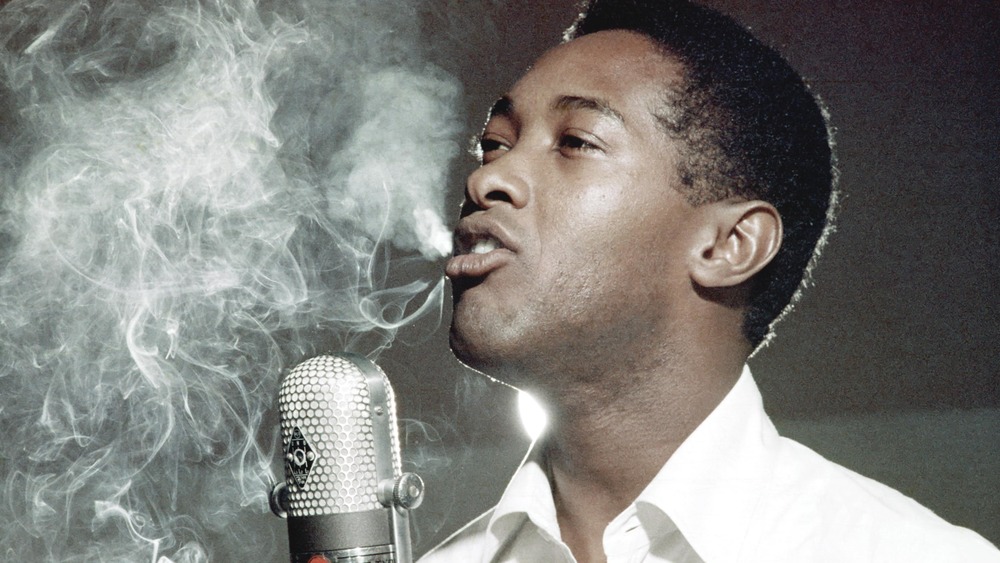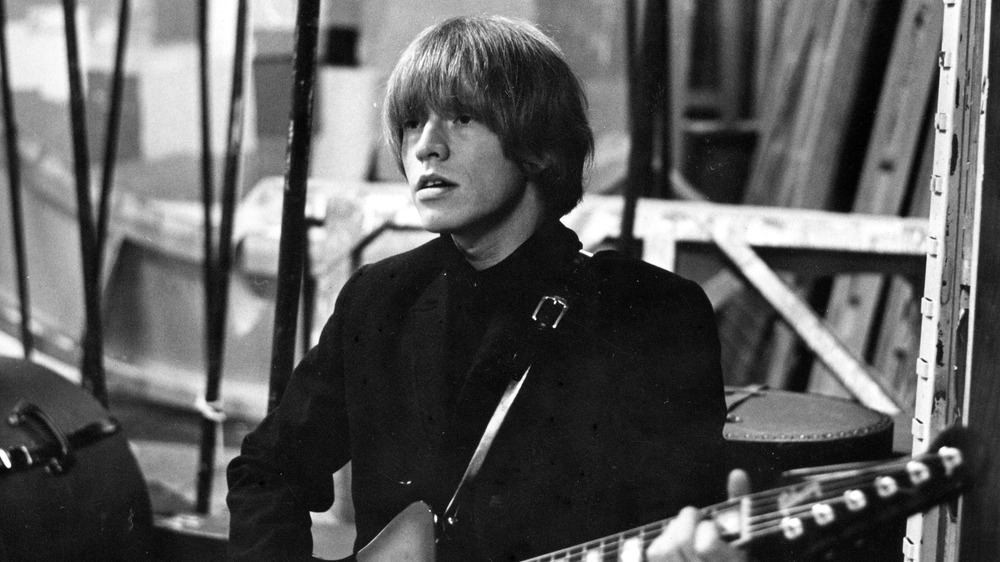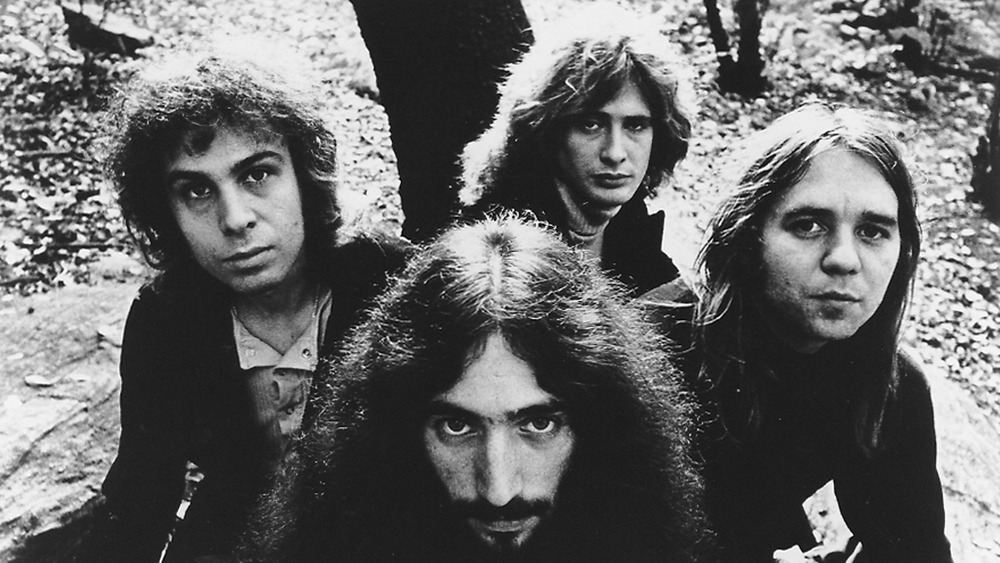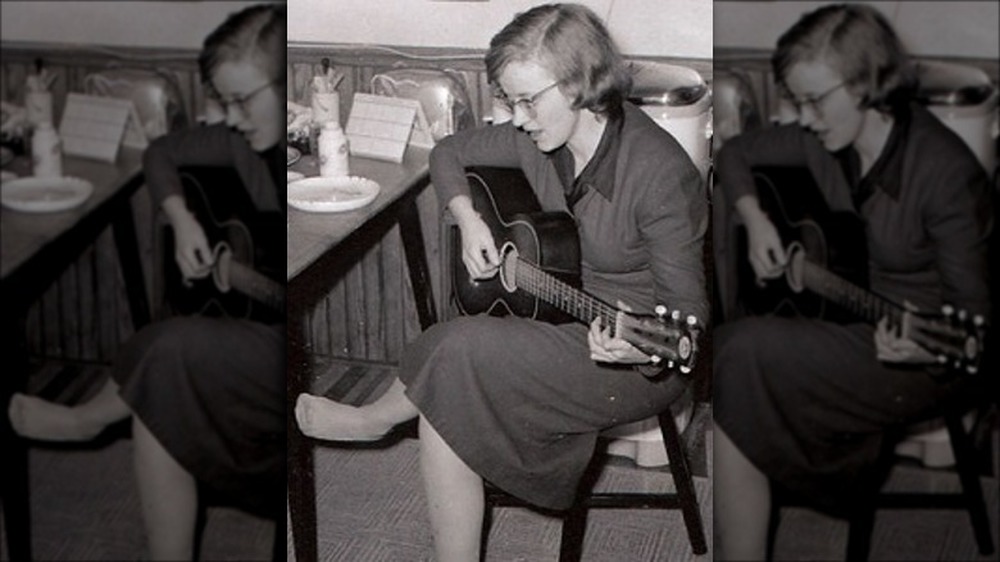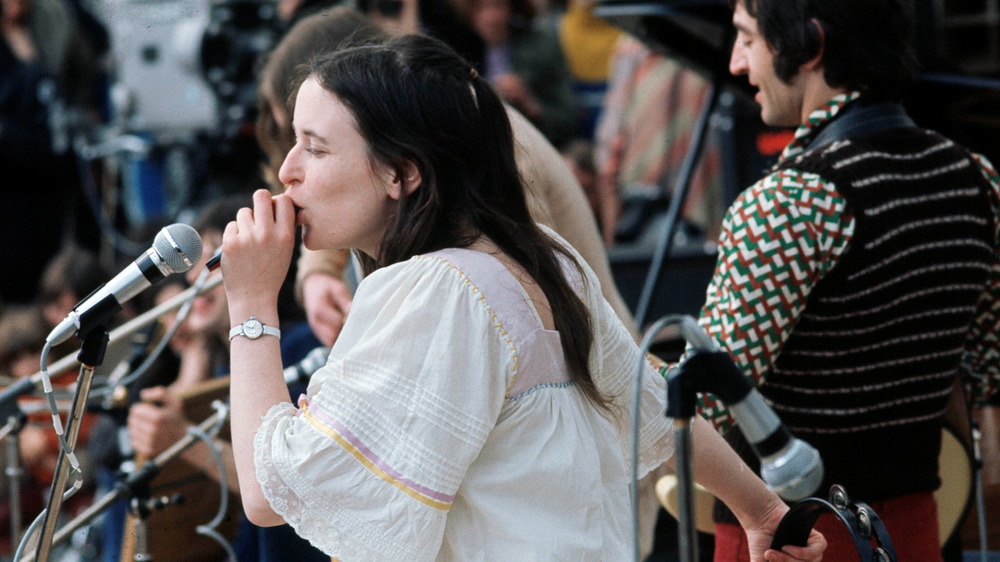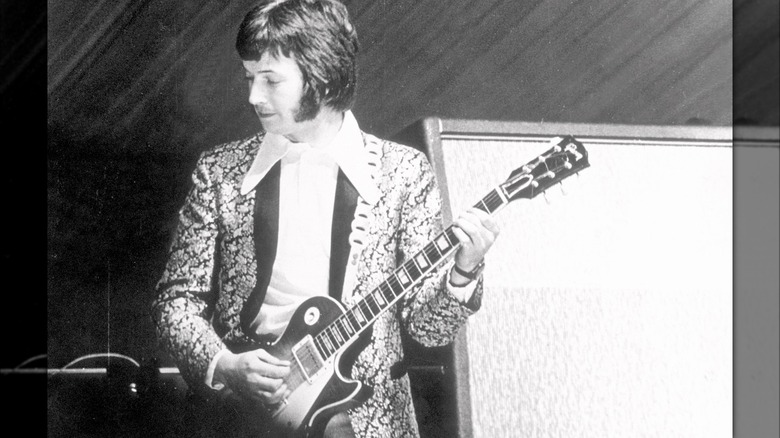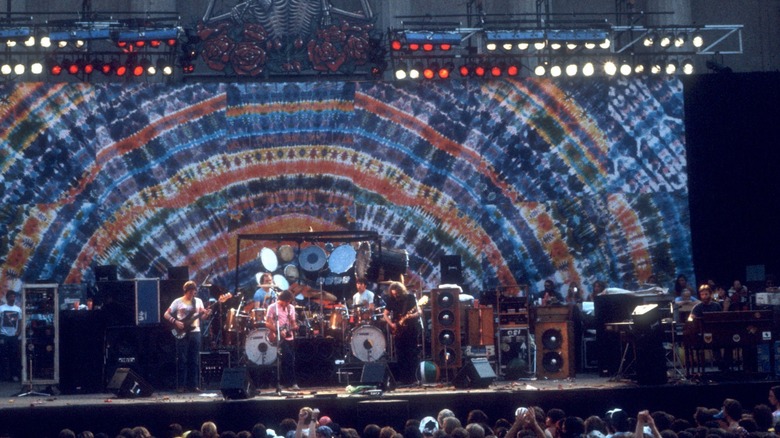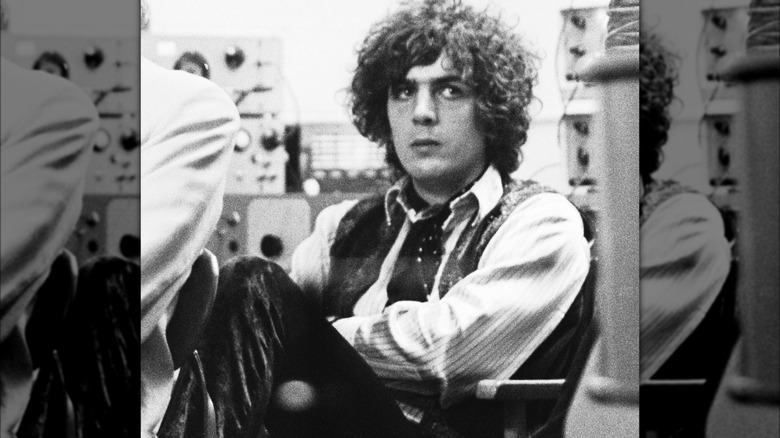The Biggest Mysteries In Classic Rock Still Unsolved Today
Rock and roll has been a powerful cultural force for more than half a century. Over the course of that half-century, plenty of larger-than-life personalities have used the power of music to create over-the-top personas, blurring the lines between reality and myth. It's easy to think of rock stars as superhuman, larger-than-life figures, so it's not terribly surprising when they're involved in crazy mysteries.
Some of these mysteries are just more myth-making, like believing that Elvis Presley faked his death and is still living somewhere under an assumed name. But some rock mysteries are very real and have resisted being solved for years or even decades. If these situations involved regular people, they wouldn't be nearly as notable. But once you add in the glamour and decadence of the rock and roll image, they become mythological. Rock stars strut outside the normal world, after all. They do things normal people can't, that normal people aren't allowed to. And they do them with style and panache. That lends credence to the possibility that the mysteries surrounding them also involve situations beyond normal understanding, and that makes them irresistible.
These puzzles may never be solved, but they'll always be fascinating. Here are the biggest mysteries in classic rock still unsolved today.
The disappearance of Richey Edwards
Back in 1995, the Manic Street Preachers were on the cusp of greatness. Melding punk, classic rock, and alternative sounds into a thick guitar sound, the band's politically charged lyrics brought frequent comparisons to their idols, The Clash. Richey Edwards, the damaged, gorgeous rhythm guitarist and lyricist, quickly became the focus of fans of the group. Edwards struggled with mental health issues, substance abuse, and self-harm (famously carving the phrase "4 REAL" into his arm while doing a live interview). But it was exactly that damage that lent his passionate, angry lyrics the emotional weight that resonated with fans.
Then Edwards vanished. On February 1, 1995, he checked out of his hotel, due to meet up with his bandmates to begin a promotional tour. He got into his car and drove to his home in Wales. He was never seen again.
His car was found near a bridge notorious as a popular site for suicides, and Richards' mental health was famously fragile. But his body was never found, and toll records show he drove over the bridge early in the morning. Fans began speculating that Edwards had faked his own death, noting that his uncle had vanished for a decade when Edwards had been young, something that had fascinated the musician. We may never know what actually happened, but Edwards was declared officially dead in 2008.
If you or someone you know is struggling or in crisis, help is available. Call or text 988 or chat 988lifeline.org
The death of Johnny Thunders
The New York Dolls were ahead of their time. Formed in 1971, this proto-punk band never quite broke through to huge success but has grown to be one of the most influential bands of the 1970s. Substance abuse and fading success tore the band apart by 1976, however, leaving the members to pursue their own careers.
Guitarist Johnny Thunders, who had become a poster boy for punk chic, struggled. The guitarist abused heroin for years, squandering his potential and losing his family. Then he pulled himself together in the 1980s and seemed to be poised for a serious comeback — only to be diagnosed with leukemia and given months to live. He moved to New Orleans intending to record one final epic album — but he never got the chance. Thunders was found dead in his apartment on April 23, 1991, likely from an overdose.
But some think he was murdered. For one thing, the apartment had been ransacked. For another, the toxicology report revealed that the level of drugs in his system wasn't enough to have killed him. And his body was found under a coffee table, folded into a "pretzel" shape.
If you or anyone you know needs help with addiction issues, help is available. Visit the Substance Abuse and Mental Health Services Administration website or contact SAMHSA's National Helpline at 1-800-662-HELP (4357).
The disappearance of Jim Sullivan
In rock and roll, as in all performing arts, we only hear about the success stories and the abject failures. The many, many artists who land somewhere in between, never attaining any sort of breakthrough success, remain largely obscure. So it is with Jim Sullivan, who built up a dedicated fan base in the late 1960s and early 1970s as an indie country-rock singer-songwriter but never "made" it. Whether or not his decision to move to Nashville for a fresh start would have yielded that breakthrough remains unknowable, however, because he vanished on the way there.
After releasing his debut album "U.F.O." in 1969 and a self-titled follow-up in 1972, Sullivan grew increasingly frustrated and developed a drinking problem. He thought relaunching his career in Music City would be a good idea, so he packed up his VW Beetle on March 4, 1975, and set off for Tennessee. Along the way, he was pulled over and given a sobriety test but passed and decided to check into a hotel for some sleep. But the room appeared undisturbed when investigators opened it up — and the key was locked inside. Sullivan's car was found 26 miles away in the middle of the desert, near a working ranch, locked and containing his possessions. He was never seen again, but his manager claims he once talked about disappearing from his life by walking out into the desert.
The death of Bobby Fuller
If you're not familiar with the name Bobby Fuller, you probably know his most famous song: "I Fought the Law," a staple of classic rock set lists across the country. Fuller didn't write the song, but his Texas-flavored rockabilly version was a smash hit in 1966, making him and the Bobby Fuller Four overnight sensations. Fuller's purely American style of rock was a contrast to the increasingly psychedelic British style popularized by the Beatles, and he was poised to be a superstar.
Then, on July 18, 1966, Fuller was found dead. His body was found in his mother's car, parked outside his apartment. It initially seemed like an obvious suicide — until the details started to come out.
The car hadn't been there half an hour before the body was found, but Fuller had been dead for some time — his body was in an advanced state of rigor mortis. This suggested he'd been moved from where he'd actually died. No one seriously investigated his death, but there are plenty of theories. The most plausible involves his record label's deep association with the Mafia, suggesting that Fuller might have fallen afoul of organized crime.
Who's so vain?
One of the few enduring rock mysteries that doesn't involve death or disappearance is the truth behind Carly Simon's famous 1972 song, "You're So Vain." Ever since the song hit the charts, people have speculated about the specific man she's singing about — the man who's so vain he probably thinks the song is about him.
That speculation went on for more than 40 years before it was partially solved. Simon confirmed a few years ago that the second verse of the song ("You had me several years ago ...") is 100% about Warren Beatty. This confirmed years of suspicion that the notorious womanizer was the man behind the song — but Simon's insistence that he's just the inspiration for the second verse means there are two other men who have yet to be identified.
Simon has said that the mystery man who inspired the first verse of the song actually inspired the whole idea. Originally, the song was called "Bless you, Ben" and had a whole different lyric and tone. When she saw a famous celebrity arrive at a party, someone remarked that he looked like he was stepping onto a yacht — and Simon ran with the idea, and a classic song was born.
Simon has since refused to offer any more clues. Billboard reports she won't reveal the men's identities until they figure it out for themselves.
The attempted murder of Bob Marley
Reggae legend Bob Marley died in 1981 from cancer. But five years before that, someone made a dramatic (and dramatically incompetent) attempt on his life — and to this day no one knows why. On December 3, 1976, a group of men wearing masks and carrying guns broke into Marley's house. They opened fire but somehow mostly missed Marley, shooting his manager Don Taylor multiple times in the chaos. Marley and his wife, Rita, were also wounded but not nearly as badly.
Jamaica's politics at the time were violent and entwined with the music industry — both the ruling People's National Party (PNP) and the rival Jamaica Labour Party (JLP) attempted to associate themselves with Marley. PNP hired guards to patrol Marley's home, but those guards were mysteriously absent that night, leading some to wonder if the PNP ordered a hit. On the other hand, some of Marley's friends were in deep debt to local gangsters, and he was helping to pay the debts for soccer player Skill Cole, so Marley was directly involved with shady dealings and might have invited trouble on himself.
No real investigation was ever performed, and to this day, no one knows for sure who tried to kill Bob Marley — or why.
Elliott Smith's death
Elliott Smith was a classic singer-songwriter who used production techniques to layer his sound, making his whispery vocals about pain and loss as powerful as a full-throated howl. After his song "Miss Misery" from the "Good Will Hunting" soundtrack was nominated for an Oscar for Best Original Song in 1998, his career was poised to explode.
Five years later, he was dead. Smith's girlfriend Jennifer Chiba says she'd locked herself in the bathroom (they'd been arguing) and then heard a scream. When she ran out of the bathroom, she found Smith standing there with a knife in his chest. She claims she ran to him and pulled out the knife, and he collapsed. She called 911, and Smith died a short time later in the hospital. A note was found that read, "I'm so sorry-love, Elliot God forgive me."
Smith had struggled with substance abuse and his mental health issues his entire life (reading the lyrics to any of his songs makes his suffering very clear), so suicide initially seemed very plausible. But the details of his death don't necessarily support suicide. The note, for example, misspells Elliott's name. There were no "hesitation wounds" typically found in self-stabbings, and the coroner's report couldn't rule out homicide. Many of Smith's fans openly accuse Chiba of murdering him, and Smith's death remains an open investigation.
Sam Cooke's death
By December 1964, Sam Cooke was one of the most successful singers working in America. His new album "Ain't That Good News" was doing well, and it contained one of Cooke's most famous songs, "A Change is Gonna Come," a song that became a major part of the Civil Rights Movement.
Cooke died on December 11, 1964. No one argues that the incident leading to his death was bizarre, and no one argues that it wasn't homicide — but as The Guardian notes, his death was officially ruled justifiable homicide, a conclusion that many people find difficult to believe.
The manager of the Hacienda Motel in Los Angeles, Bertha Franklin, claimed Cooke attempted to rape a young woman he'd forced into his room. (Writer Peter Guralnick notes that the woman, Elisa Boyer, actually did call the police to report this.) Cooke then burst into the motel's office, nearly naked, and demanded to know where Boyer was. Franklin claimed she shot Cooke in self-defense. But singer Etta James — who was present when Cooke's body was removed from the motel — claims his injuries were much more severe than what Franklin reported. This has caused some to speculate that Cooke might have been killed because of his growing activism or because of criminal elements who wished to control his growing fortune and song-publishing empire.
The drowning of Brian Jones
By 1969, Brian Jones was officially no longer in the band he co-founded, the Rolling Stones. But in truth, Jones hadn't really been in the band for a long time. He only performed on two songs on the band's 1969 album "Let It Bleed" – and those contributions were hardly essential. Jones had fallen into a deep pit of drug addiction and estrangement from his bandmates, and he was fired in June.
A few weeks later, Jones was found dead in his pool. His death was ruled "death by misadventure," which is an official way of saying he took a lot of drugs and fell into the water. But there's a lot of evidence suggesting he might have been murdered.
Contractor Frank Thorogood has long been suspected of being involved in Jones' death. Jones hired Thorogood to do work on his remote farm, but the two had a bitter falling out over money Thorogood claimed he was owed. The two had an altercation in the pool, and Thorogood reportedly entered the house shaking badly just as Jones' body was spotted and acted very strangely once the musician was confirmed dead. Jones' manager, Tom Keylock, claims his brother (a senior police officer) said that the police made mistakes in their investigation and decided to cover it up by supporting the accidental death conclusion. The case was briefly reopened in 2009 but then closed again.
Gary Driscoll's murder
Gary Driscoll (rightmost above) might not be a household name, but his death in 1987 is one of the most bizarre unsolved murders in classic rock history.
Driscoll was an accomplished drummer with a classic R&B style. He began a professional partnership with Ronnie James Dio in the 1960s, playing with Dio through a succession of bands that didn't quite break through to major success. In 1975, Deep Purple co-founder and guitarist Richie Blackmoore asked Dio and other members of his band Elf (including Driscoll) to form a new band with him, the legendary early heavy metal act Rainbow. Blackmoore and Dio weren't happy with the way their first album sounded, and Driscoll was fired.
Driscoll went on to play in a few more bands, but his fortunes faded. He took on some odd jobs and did some session drumming to pay the bills. In June 1987, Driscoll was found dead in his house in Ithaca, New York. Writer Jeremy Simmonds notes that Driscoll was known to dabble in drugs, that the murder was very likely drug-related, and that more than one person was involved. But there are indications that the murder was ritualistic and had occult trappings — including a persistent, if unproven, rumor that Driscoll was partially flayed. No one has ever been convicted of the crime.
Connie Converse's disappearance
Connie Converse remains an obscure musician, but she's increasingly recognized as a singer-songwriter who was quite simply ahead of her time. Arriving in New York in the 1940s after dropping out of college, she moved into an apartment in Greenwich Village just as it was transforming into a focal point for artists of all kinds.
Converse began writing songs on her guitar. Her style was unique, and her songs were complex and musically sophisticated. People were blown away, and after appearing at a local showcase in 1954, she found herself on television as a guest of CBS' "The Morning Show," hosted by Walter Cronkite. Things seemed to be happening for Converse ... until they weren't. Her music was too out there, and the folk movement that might have propelled her hadn't yet arrived. Frustrated, she left New York City in 1961 – around the same time some guy named Bob Dylan arrived.
Converse moved to Ann Arbor, Michigan, and took on teaching jobs and tried to write a novel. She began to drink and sank into a depression. In August 1974, she wrote a series of strange letters to her friends and family, talked about a fresh start, and then got into her car and drove off. She was never seen again, and her car was never found. Many wonder if she actually did pull an Elvis and start over under a new identity.
Licorice McKechnie's disappearance
The Incredible String Band formed in the 1960s and built a reputation as one of the most interesting folk-rock groups in history, merging '60s psychedelia with traditional folk arrangements to create a unique sound. They were popular enough to be invited to appear at the famous Woodstock festival in 1969 — though the crowd's reaction wasn't great.
Christine "Licorice" McKechnie was romantically involved with co-founder Robin Williamson and became a primary singer and songwriter with the band during the height of their success. After she and Williamson broke up, she left the band in 1972. (The band broke up completely in 1974.) McKechnie performed sporadically over the course of the next 15 years but slowly faded from public view.
By 1987, McKechnie was in the United States, and the last time anyone saw her, she was preparing for a trek through the Arizona desert — although her sister claims she was in contact with her in 1990. Either way, no one has heard from or seen Licorice McKechnie in at least three decades, and no one has any idea what happened to her. She simply vanished into thin air.
Where did the Dark Side of the Rainbow come from?
One of the oddest phenomena in rock is undoubtedly the enigma known as the "Dark Side of the Rainbow." The name refers to the supposed coincidences that occur if someone syncs up Pink Floyd's album "The Dark Side of the Moon" with the movie "The Wizard of Oz." Some instances include Dorothy Gale being knocked out by a tornado as Clare Torry wails on the track "The Great Gig in the Sky," and the lyrics to "Us and Them" coinciding with Dorothy and the Wicked Witch's outfits.
Yet, the band has always denied there was any intent, and they say any connection is purely coincidental or confirmation bias on the part of the listener. Regardless, the real question is: Who on earth came up with the idea to mash up the album and movie together in the first place? The legend seems to have first appeared in the mid-1990s among Floyd fans on what was then the brand-new internet, but nobody took credit for coming up with the idea, and even then most were skeptical of the phenomena at all.
There is truly no logical reason to have tried to combine the two, leaving open the possibility it spawned from a cosmic accident in some Floyd fan's basement. It's unlikely anyone will credibly claim to be the inventor, so this is one mystery truly destined to remain unsolved forever.
Jim Morrison's death
When Jim Morrison died on July 3, 1971, it was a complete shock to practically everyone. At the time of his demise, Morrison was living in Paris with his girlfriend Pamela Courson (pictured with Morrison) after leaving his home in Miami following an arrest and conviction for indecent exposure. His death caught practically everyone by surprise, but the murky and vague details behind it and the seeming haste of his burial immediately raised questions.
It's thought that Morrison died sometime in the early hours of the morning while in his Paris apartment with Courson. When Courson woke up from being asleep, she says she found Morrison dead in the tub, and the paramedics could not resuscitate him when they arrived. Courson claims that Morrison died of natural causes, and his official cause of death was a heart attack. However, the police did not perform an autopsy or toxicology test, and Courson had him buried relatively quickly within days, while the news was not made public until well after the funeral.
The majority of fans and friends have always argued that it was in fact an overdose of heroin that caused Morrison's death and not natural causes. Some even claim Courson denied the autopsy and lied to police to save herself potential prosecution for drugs. More wild claims include that he overdosed in a club and drug dealers brought him to the apartment, to the CIA secretly orchestrating the murder, though those seem less grounded in reality.
What happened to Adam Katz at the Grateful Dead concert?
As the Grateful Dead were playing to thousands of screaming fans at the Meadowlands Arena on October 14, 1989, Deadhead Adam Katz was dying just outside the venue. It's unclear exactly what led to this point, but during the concert, a passing motorist saw Katz's body on the roadside under an overpass, unconscious and on his back. He had been incapacitated by blunt force trauma to the head, and a day later he passed away.
Authorities quickly leaned towards two possibilities. Either Katz had jumped from the overpass, possibly the result of a bad LSD experience. Or there was the much darker prospect, that someone had murdered him. Homicidal suspicion quickly fell onto the security guards working the venue, and one 16-year-old witness later claimed one of the guards told him they had seen other guards severely beat Katz before dumping his body on the road.
Unrelated to Katz's death, authorities had charged nine security guards working the concerts with excessive force against fans, including the guard the witness had named, confirming their violent tendencies. In 1991, Katz's parents filed a lawsuit against New Jersey, buoyed by evidence from the FBI they claimed showed Katz had been in a security van that night, as well as indications the police had helped cover up the crime. As of 2023, there were still no arrests, and Katz was only 19 years old when he died.
The 1973 Summer Jam disappearances
The 1973 Summer Jam festival at Watkins Glen in New York was one of the most legendary rock concerts of all time. Acts like the Grateful Dead and Allman Brothers Band were there, and estimates put the attendance at well over half a million. Unfortunately, teenagers Mitchel Weiser and Bonnie Bickwit likely never had a chance to revel in the fun. The two high school students from Brooklyn were dating, and Weiser took a bus to meet Bickwit at her job as a camp counselor so they could head up together.
Bickwit quit in order to attend the festival, and the pair planned on hitchhiking their way to Watkins Glen, about 150 miles to the northwest. They left on July 27, 1973, the day before the festival, and nobody knows what happened to them on the way, or if they even made it to Summer Jam at all. Eyewitnesses recall seeing them hitchhiking on the side of the highway with a cardboard sign. One trucker even apparently picked them up not too far from Bickwit's camp and gave them a brief ride up the highway, but that's where the trail goes cold.
When Weiser did not return home and Bickwit did not return to camp to get her things, both of their families started to worry and alerted the police. More than 50 years later, nobody has ever come forward with critical information on their whereabouts, and their bodies have never been found.
Jimi Hendrix's suspicious death
Jimi Hendrix was only 27 years old when he died on September 18, 1970, from an overdose of barbiturate sleeping pills, and questions have persisted to this day about what really happened that fateful morning. Hendrix was with his girlfriend Monika Dannemann (pictured above) at the time, and according to her Hendrix's death was an accident. Hendrix had taken sleeping pills that morning prescribed to Dannemann, and he took well more than the recommended dose, leading to his incapacitation and eventual asphyxiation on his own vomit.
When Hendrix's close friend Eric Burdon arrived hours later he found what he thought was a suicide note, though that later turned out not to be the case. Burdon later suggested in his autobiography "Don't Let Me Be Misunderstood" that some of Hendrix's friends were privately suspicious that Dannemann had killed him on purpose, but she was never charged or arrested. Most people believe that the death was accidental, but that has not stopped the conspiracies from emerging.
Of all the potential theories, perhaps the most dubious is from James "Tappy" Wright's autobiography "Rock Roadie." In the book, Wright alleges that Hendrix's former manager Michael Jeffrey was a former British Secret Service agent who confessed to murdering Hendrix by force-feeding him pills and wine. Jeffrey allegedly did so because he thought Hendrix was going to replace him with a new manager, and he also may have had a lucrative insurance policy on Hendrix, too.
Paul McCartney's missing Höfner bass
For many rock music fans, Paul McCartney is synonymous with his Höfner 500/1 model violin-shaped bass. They are an inseparable pairing, and it's hard to imagine McCartney playing anything else, especially during his time with the Beatles. The history of McCartney and Höfner dates back to 1961 when he first joined the Beatles. McCartney's first-ever bass was a 500/1 Höfner, and he only got it because it was relatively cheap compared with the others available.
McCartney used the original '61 Höfner for about two years until he relegated it to backup status when he got a brand new one to replace it in October 1963. McCartney kept the '61 Höfner around, and he likely practiced on it during the "Let It Be" sessions in January 1969, which is the last time it was ever seen. It's thought someone put it into storage either at Abbey Road Studios or at Apple Records, at which point a thief pilfered it without anyone realizing. Around the same time, someone also stole one of George Harrison's guitars, so the prospect is not too far-fetched.
In September 2023, a group of investigative journalists and an expert on Höfners started a website, TheLostBass.com. They are attempting to track down the instrument to return to McCartney, but so far have proven unable. If the bass is still out hopefully they'll find it, though prospects are slim, but at least McCartney has others.
Who robbed Led Zeppelin in 1973?
Among rockers, Led Zeppelin's 1973 "The Song Remains the Same" is undoubtedly one of the most iconic concert movies ever. The band shot the film over three nights in July 1973 at Madison Square Garden in New York City, and when it hit theaters a few years later it was a huge hit. However, what's not captured on film, is that during the run at MSG, someone stole a huge chunk of cash out of their hotel lockbox. Originally, The New York Times reported that someone had stolen $202,600, but that was later revised to $180,000, still a very significant sum.
Since the safety deposit box appeared to have been opened by the key rather than broken into, and there was only one key, police questioned the band's manager Robert Cole, but he passed a lie detector test and they quickly ruled him out. In addition to the cash, the band's passports were also in the box, and Cole last saw the money in it at around 11:20 on the morning of July 29, the day before the robbery. The band was supposed to fly home to London but had to delay while the police investigated, though it didn't do much good.
The police never solved the case or even made any arrests, and they long suspected it was an inside job. The band seemed to largely laugh off the incident and return home, but the $180,000 is still missing.
The disappearance and death of Philip Taylor Kramer
Before his disappearance, most people probably barely remembered Philip Taylor Kramer's brief flirtation stint as the bass player for Iron Butterfly in the mid-1970s. By the time of his still unexplained disappearance on February 12, 1995, Kramer's touring days were long in the past. He was now an accomplished aerospace engineer who had founded his own tech company worth more than $1.5 million in the early 1990s, though it was in bankruptcy at the time of his disappearance.
Associates reported that his erratic work habits and infatuation with the spiritual novel "The Celestine Prophecy" started to affect his personality, and he was also becoming deprived of sleep, too. The morning that he disappeared, he was supposed to pick up one of his company's directors, but he never showed. Records show that made more than a dozen calls that morning instead, including one to 911 where he told them that not only was he contemplating dying by suicide, but that, bizarrely, O.J. Simpson was innocent (the Simpson murder trial was going on at the same time).
Kramer vanished without a trace for just over four years until May 29, 1999, when authorities found his remains at the bottom of a 200-foot ravine in Malibu, California. They identified his decayed body by his dental records, and it was unclear how long he had been there. Theories about his death range from suicide to potentially a kidnapping gone wrong, but authorities have never solved the case.
Who stole Eric Clapton's guitar?
In the mid-1960s, few guitarists had the critical and commercial success of bluesman Eric Clapton, who blew minds with his impeccable playing in bands like the Yardbirds and John Mayall's Bluesbreakers. For many, his guitar work on "Blues Breakers With Eric Clapton" is some of the best of his entire career, and he did it while playing a beautiful 1959 or 1960 Gibson Les Paul.
Fans became enamored with Clapton as well as the guitar, and it got the nickname "The Beano Burst." The nickname came from the album being known as "The Beano Album" due to its cover, as well as the guitar's sunburst gold finish. However, Clapton only got to play the guitar for one album, because an unknown person lifted it along with one of Clapton's most favorite guitar straps in 1966. Clapton was just forming the band Cream when he left the Bluesbreakers, and it was during their first rehearsals, in a church hall of all places, that he found the guitar was missing.
Clapton was notably distraught over the loss, going as far as to tell a journalist specific features about it in hopes that someone would recognize it so it would find its way back to him, but it never did. Joe Bonamassa once claimed a private collector owned it, but even he seemed to later backtrack, and no one has publicly said where it is today, if it even still exists.
The cause of Deadhead Patrick Shanahan's death
On December 10, 1989, 19-year-old Patrick Shanahan turned up at the Grateful Dead show in Inglewood, California, hoping to connect with the band once again. Despite his young age, Shanahan was a veteran Deadhead who'd already attended dozens of shows, and he was also known to use the psychedelic hallucinogen LSD.
At the Dead show, Shanahan took an unknown quantity of LSD, and according to eyewitnesses he started to have a bad experience and abruptly left the performance during the second set while waving his hands. Once outside, Shanahan's bizarre actions while hallucinating got him into an altercation with some of the police officers, and they detained him by binding his legs and arms together after he allegedly tried to bite and kick them. On the way to the station, they realized he was not breathing and took him to the hospital, where he was pronounced dead.
The coroner listed the official causes of death as neck compression in combination with LSD intoxication and injuries from being beaten by nightsticks. However, the police denied that they had used excessive force or caused his death, despite several witnesses attesting to their excessive use of force. The police maintain that drugs caused Shanahan to stop breathing and not their actions. His parents later filed a lawsuit against the city alleging wrongful death, but we'll likely never know the real reason for Shanahan's death, or who was ultimately responsible.
The 1993 murder of AC/DC's manager
Crispin Dye was the former manager of the famous Australian rock band AC/DC for several years, and he was beginning to embark on his own rock career as a solo artist when he was tragically and brutally murdered at an Australian pub in Surry Hills in 1993. A member of the LGTBQ+ community, for some unknown reason Dye either got into a fight or was accosted by somebody, leaving him severely injured.
Whoever beat Dye also stole his wallet, and he passed away two days later on Christmas. With slim leads, many suggested that Dye's sexual orientation may have been related to the murder, as other similar incidents had been linked to homophobia in the area, but nothing came up. After years of inactivity, police reopened the case in 2014 and offered $100,000 in rewards, but still no one came forward.
The biggest development in the case came in 2023. Investigators looking into LGBTQ+ hate crimes reopened the case and realized that not only was there handwritten evidence from Dye that had gone undiscovered, but his bloodstained clothes had never been tested for DNA. When a lab tested them in 2023, they found the DNA a match to an unknown suspect from a previous 2002 home break-in, though they did not release his identity. The police have not announced any arrests or new developments since the DNA testing, but they just might be able to bring Dye's family some justice after all.
Who was Arnold Layne?
Among Pink Floyd's earliest singles, the song "Arnold Layne" has a special place in many of their fans' hearts. Not only was "Arnold Layne" the first single they released after being signed to a record deal, but it has some of the most outrageous lyrics of any Floyd song ever. The song's narrator describes a thief who has the "strange hobby" of stealing and wearing women's clothes from washing lines, which eventually leads to his imprisonment.
In a 1967 interview with Melody Maker, Barrett claimed that he used the name because he thought it fit the music well, but rumors have always abounded that the moniker actually refers to a real thief who lived near Barrett's home in Cambridge. Apparently, the Steam Laundry Cottages development in Cambridge had a notable family with the last name of Arnold, and one of them was a petty criminal and thief. He sold stolen clothes and used the profits to buy booze, and according to the Museum of Cambridge, a member of the Arnold family claims that Barrett may have actually bought some clothes from the thief himself.
However, the family member never mentioned the first name of the alleged thief, and the Floyd song reverses his names, probably as a reference to the cottages' nickname of "Arnold Lane" due to the preponderance of locals with the last name. We'll probably never know Arnold's first name, or if he even existed at all, but it's a funny story either way.
